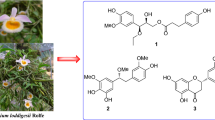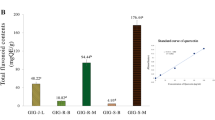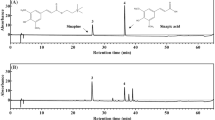Abstract
This study aimed to investigate the potential of Mangifera indica L. seed kernel extract, which is highly discarded by the global food processing industry, as a multifunctional bioactive ingredient for nutraceutical and cosmeceutical applications. Different extracting solvents were utilized, the extracts were then tested for their antioxidant activities using DPPH, ABTS radical scavenging assays, and inhibition of lipid peroxidation. Additionally, total phenolic content (TPC), total flavonoid content (TFC), and gallic acid content were elucidated using Folin–Ciocalteu and aluminum chloride colorimetric assays, as well as high performance liquid chromatography. The hydroethanolic extract (KMHE) exhibited the highest percentage yield, with the highest antioxidant activity owing to its high phenolic content. KMHE consisted of 773.66 ± 9.42 mg GAE/g extract in TPC, 36.20 ± 4.20 mg RU/g extract in TFC. Additionally, gallic acid was shown to be a major constituent of KMHE. KMHE was investigated for anti-tyrosinase, anti-hyaluronidase, anti-MMP-2, and anti-MMP-9 activities. Moreover, the anti-inflammatory effects of KMHE were studied in RAW 264.7 cells induced by nitric oxide and KMHE was shown to prevent DNA damage, indicating an inhibitory effect on cellular aging. KMHE showed outstanding anti-tyrosinase activity and was as potent an anti-hyaluronidase as gallic acid. Additionally, our results reveal notable anti-MMP-2 and anti-MMP-9 effects that were not significantly different from those of gallic acid. Furthermore, KMHE demonstrated 61.54 ± 2.39% nitric oxide inhibition, with no cytotoxic effects, in RAW264.7 cells, and also prevented DNA damage in the human fibroblast BJ cell line with no cytotoxic effects. Therefore, KMHE could be a promising, natural multifunctional bioactive compound for nutraceutical and cosmeceutical applications.







Similar content being viewed by others
References
Zhang S, Duan E (2018) Fighting against skin aging: the way from bench to bedside. Cell Transplant 27:729–738. https://doi.org/10.1177/0963-6897.1772.5755
Yaar M, Eller MS, Gilchrest BA (2002) Fifty years of skin aging. Perspect Progr Cutaneous Biol 7:51–58. https://doi.org/10.1046/j.1523-1747.2002.19636.x
Cao C, Xiao Z, Wu Y, Ge C (2020) Diet and skin aging-from the perspective of food nutrition. Nutrients 12:870–895. https://doi.org/10.3390/nu12030870
Masaki H (2010) Role of antioxidants in the skin: anti-aging effects. J Dermatol Sci 58:85–90. https://doi.org/10.1016/j.jdermsci.2010.03.003
Tundis R, Loizzo MR, Bonesi M, Menichini F (2015) Potential role of natural compounds against skin aging. Curr Med Chem 22:1515–1538. https://doi.org/10.2174/0929867322666150227151809
Lauricella M, Emanuele S, Calvaruso G, Giuliano MD, Anneo A (2017) Multifaceted health benefits of Mangifera indica L. (Mango): the inestimable value of orchards recently planted in Sicilian rural areas. Nutrients 9:1–14. https://doi.org/10.3390/nu9050525
Pravez M (2016) Pharmacological activities of mango (Mangifera indica): a review. J Pharmacogn Phytochem 5:1–7
Office of Agricultural Economics (2017) Agricultural import and export data. Ministry of Agriculture and Co-operation, The Royal Thailand Government. http://www.oae.go.th/assets/portals/1/files/jounal/2561/thailandtradestat2560.pdf. Accessed 18 June 2020
Shah KA, Patel MB, Patel RJ, Parmar PK (2010) Mangifera indica (mango). Pharmacogn Rev 4:42–48. https://doi.org/10.4103/0973-7847.65325
Jahurul MHA, Zaidul ISM, Ghafoor K, Al-juhaimi F, Nyam K, Norulaini NAN et al (2015) Mango (Mangiferin indica L.) by-products and their valuable components: a review. Food Chem 183:173–180. https://doi.org/10.1016/j.foodchem.2015.03.046
Poomanee W, Chaiyana W, Mueller M, Viernstein H, Khunkitti W, Leelapornpisid P (2018) In-vitro investigation of anti-acne properties of Mangifera indica L. kernel extract and its mechanism of action against Propionibacterium acnes. Anaerobe 52:64–74. https://doi.org/10.1016/j.anaerobe.2018.05.004
Department of Medical Sciences, Ministry of Public Health (2018) Thai Herbal Pharmacopoeia. 1st ed. Keawjawjom printing and Publishing Suan Sunandha Rajaphat University, Bangkok, Thailand, pp 522–532
Floegel A, Kim D, Chung S, Koo SI, Chun OK (2011) Comparison of ABTS/DPPH assays to measure antioxidant capacity in popular antioxidant-rich US foods. J Food Compos Anal 24:1043–1048. https://doi.org/10.1096/fasebj.24.1_supplement.535.9
Shabir GA (2003) Validation of high-performance liquid chromatography methods for pharmaceutical analysis, understanding the differences and similarities between validation requirements of the US Food and drug administration, the US pharmacopeia and the international conference on harmonization. J Chromatogr A 987:57–66. https://doi.org/10.1016/S0021-9673(02)01536-4
Babu S, Sudhakar V, Murthy TEGK (2014) Validated HPLC method for determining related substances in compatibility studies and novel extended release formulation for ranolazine. J Chromatogr Sep Tech 5:1–7. https://doi.org/10.4172/2157-7064.1000209
Poomanee W, Chaiyana W, Intasai N, Leelapornpisid P (2015) Biological activities and characterization of the pod extracts from Sompoi (Acacia concinna Linn.) grown in Northern Thailand. Int J Pharm Pharm Sci 7:237–241. https://doi.org/10.1016/j.ajps.2017.03.001
Chaiyana W, Auchapreeda S, Punyoyai C, Neimkhum W, Lee K-H, Lin W-C et al (2019) Ocimum sanctum Linn. as a natural source of skin anti-ageing compounds. Ind Crop Prod 127:217–224. https://doi.org/10.1016/j.indcrop.2018.10.081
Ajila CM, Brar SK, Verma M, Tyagi RD, Godbout S, Velero JR (2010) Extraction and analysis of polyphenols: recent trends. Crit Rev Biotechnol. https://doi.org/10.3109/07388551.2010.513677
Karunakaran T, Ismail IS, Ee GCL, Nor SMM, Palachandran K, Santhanam RK (2018) Nitric oxide inhibitory and anti-Bacillus activity of phenolic compounds and plant extracts from Mesua species. Rev Bras Farmacogn 28:231–234. https://doi.org/10.1016/j.bjp.2018.01.007
Sairam K, Hemalatha S, Kumar A, Venkataraman S (2003) Evaluation of anti-diarrhoeal activity in seed extracts of Mangifera indica. J Ethnopharmacol 84:11–15. https://doi.org/10.1016/s0378-8741(02)00250-7
Rajan S, Prave Thirunalasundari T, Jeeva S (2013) Anti-enteric bacterial activity and phytochemical analysis of the seed kernel extract of Mangifera indica Linnaeus against Shigella dysenteriae (Shiga, corrig.) Castellani and Chalmers. Asian Pac J Trop Med 4:294–300. https://doi.org/10.1016/S1995-7645(11)60089-8
Do QD, Angkawijaya AE, Tran-Nguyen PL, Huynh LH, Soetaredjo FE, Ismadji S et al (2014) Effect of extraction solvent on total phenol content, total flavonoid content, and antioxidant activity of Limnophila aromatica. J Food Drug Anal 22:296–302. https://doi.org/10.1016/j.jfda.2013.11.001
Pawar CR, Surana SJ (2010) Optimizing conditions for gallic acid extraction from Caesalpinia decapetala wood. Pak J Pharm Sci 23:423–425
Mojzer EB, Hrnˇciˇc MK, Škerget M, Knez Ž, Bren U (2016) Polyphenols: extraction methods, antioxidative action, bioavailability and anticarcinogenic effects. Molecules 21:901–939. https://doi.org/10.3390/molecules21070901
Perron NR, Brumaghim JL (2009) A review of the antioxidant mechanisms of polyphenol compounds related to iron binding. Cell Biochem Biophys 53:75–100. https://doi.org/10.1007/s12013-009-9043-x
Ebanks JP, Wickett RR, Boissy RE (2009) Mechanisms regulating skin pigmentation: the rise and fall of complexion coloration. Int J Mol Sci 10:4066–4087. https://doi.org/10.3390/ijms10094066
Zuo A, Dong H, Yu Y, Shu Q, Zheng L, Yu X et al (2018) The antityrosinase and antioxidant activities of flavonoids dominated by the number and location of phenolic hydroxyl groups. Chin Med 13:51–63. https://doi.org/10.1186/s13020-018-0206-9
Zolghadri S, Bahrami A, Khan MTH, Munoz-Munoz J, Garcia-Molina F, Garcia-Canovas F et al (2019) A comprehensive review on tyrosinase inhibitors. J Enzyme Inhib Med 34:279–309. https://doi.org/10.1080/14756366.2018.1545767
Philips N, Auler S, Hugo R, Conzalez S (2011) Beneficial regulation of matrix metalloproteinases for skin health. Enzyme Res. https://doi.org/10.4061/2011/427285
Pittayapruek P, Meephansan J, Prapapan O, Komine M, Ohtsuki M (2016) Role of matrix metalloproteinases in photoaging and photocarcinogenesis. Int J Mol Sci 17:868–888. https://doi.org/10.3390/ijms17060868
Quan T, Qin Z, Xia W, Shao Y, Vorrhees JJ, Fisher GJ (2009) Matrix-degrading metalloproteinases in photoaging. J Investig Dermatol Symp Proc 14:20–24. https://doi.org/10.1038/jidsymp.2009.8
Calabriso N, Massaro M, Scoditti E, Pellegrino M, Ingrosso I, Giovinazzo G et al (2016) Red grape skin polyphenols blunt matrix metalloproteinase-2 and -9 activity and expression in cell models of vascular inflammation: protective role in degenerative and inflammatory diseases. Molecules 21:1147–1165. https://doi.org/10.20944/preprints201912.0030.v1
Baumann L (2007) Skin ageing and its treatment. J Pathol 211:241–251. https://doi.org/10.1002/path.2098
Papakonstantinou E, Roth M, Karakiulakis G (2012) Hyaluronic acid: a key molecule in skin aging. Dermato-Endocrinology 4:253–258. https://doi.org/10.4161/derm.21923
Bralley E, Greenspan P, Hargrove JL, Hartle DK (2007) Inhibition of hyaluronidase activity by Vitis rotundifolia. (Muscadine) berry seeds and skins. Pharm Biol 45:667–673. https://doi.org/10.1080/13880200701545018
Kolayli S, Can Z, Yildiz O, Sahin H, Karaoglu SA (2016) A comparative study of the antihyaluronidase, antiurease, antioxidant, antimicrobial and physicochemical properties of different unifloral degrees of chestnut (Castanea sativa Mill.) honey. J Enzyme Inhib Med Chem 31:96–104. https://doi.org/10.1080/14756366.2016.1209494
Thornfeldt CR (2008) Chronic inflammation is etiology of extrinsic aging. J Cosmet Dermatol 7:78–82. https://doi.org/10.1111/j.1473-2165.2008.00366.x
Conforti F, Menichini F (2011) Phenolic compounds from plants as nitric oxide production inhibitors. Curr Med Chem 18:1137–1145. https://doi.org/10.2174/092986711795029690
Ippoushi K, Azuma K, Ito H, Horie H, Higashio H (2003) [6]-Gingerol inhibits nitric oxide synthesis in activated J774.1 mouse macrophages and prevents peroxynitrite-induced oxidation and nitration reaction. Life Sci 73:3427–3437. https://doi.org/10.1016/j.lfs.2003.06.022
DeMarini DM, Claxton LD (2006) Outdoor air pollution and DNA damage. Occup Environ Med 63:227–229. https://doi.org/10.1136/oem.2005.025502
Panich U, Sittithumcharee G, Rathviboon N, Jirawatnotai S (2016) Ultraviolet radiation-induced skin aging: the role of DNA damage and oxidative stress in epidermal stem cell damage mediated skin aging. Stem Cells Int. https://doi.org/10.1155/2016/7370642
Giorgio M, Trinei M, Migliaccio E, Pelicci PG (2007) Hydrogen peroxide: a metabolic by-product or a common mediator of ageing signals. Nat Rev Mol Cell Biol 8:722–728. https://doi.org/10.1038/nrm2240
Acknowledgements
This research was funded by the Agricultural Research and Development Agency (Public organization, ARDA) Thailand and partially supported by Chiang Mai University grant. The possible APC was funded by Innovation Center for Holistic Health, Nutraceuticals, and Cosmeceuticals, Faculty of Pharmacy, Chiang Mai University.
Author information
Authors and Affiliations
Corresponding author
Ethics declarations
Conflict of interest
The authors declare that they have no conflict of interest.
Rights and permissions
About this article
Cite this article
Poomanee, W., Khunkitti, W., Chaiyana, W. et al. Multifunctional biological properties and phytochemical constituents of Mangifera indica L. seed kernel extract for preventing skin aging. Toxicol Res. 37, 459–472 (2021). https://doi.org/10.1007/s43188-020-00079-6
Received:
Revised:
Accepted:
Published:
Issue Date:
DOI: https://doi.org/10.1007/s43188-020-00079-6




